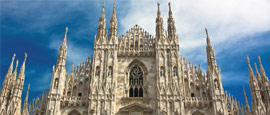Milan History
Milan’s history stretches back to a Celtic settlement in 400BC. It was conquered by the Romans in 222BC and later became the capital of the Western Roman Empire.
As the Empire declined over subsequent centuries, the city was invaded by many different groups, including the Visigoths, Huns and Lombards.
During the Middle Ages, Milan flourished as a trade hub. From the 13th and 15th centuries, the powerful Visconti family ruled and brought a period of glory and wealth to the city. Under them, the magnificent Duomo cathedral was built in 1386.
Although Milan grew as in important Renaissance city from the 15th century, it would have to put up with French, Spanish and Austrian rulers until Italian unification in 1871.
The Kingdom of Italy had, in fact, been declared by Napoleon at the turn of the 19th century, but when his occupation ended in 1814, the Lombard region, including its capital of Milan, came under Austrian control. The Austrians were finally given the boot in 1859 after numerous Milanese rebellions.
Although Rome was appointed the capital after the final phase of unification, Milan swiftly became the real economic and cultural leader. It developed into a pivotal industrial base, with rail links expanding out from the city, and Milanese banks gaining financial dominance over the country.
It was here that the fascist leader Benito Mussolini rose to prominence in the early 20th century. He and his followers marched on Rome in 1922, seizing control of the country. As a centre of Italian fascism, Milan was bombed heavily by the Allies during WWII. It's a miracle that so many historic treasures survived from this period, including La Scala opera house, Castello Sforzesco and The Last Supper by Da Vinci.
After the war, the population increased as southern migrants came seeking work, and modern skyscrapers such as the Velasca and Pirelli Towers began to pop up. By the 1980s, many fashion houses that were based in the city (including Armani, Versace and Dolce & Gabanna) became globally successful and Milan was transformed into one of the world’s leading fashion capitals.
Did you know?
• Leonardo Da Vinci’s The Last Supper suffered a direct hit from an Allied bombing raid, but survived because the wall it adorned in the church of Santa Maria delle Grazie was sandbagged.
• Although he has gone down in history as one of the world’s most infamous fascists, Mussolini was originally a prominent figure in the Italian Socialist Party and the editor of its newspapers. He was ousted for his vociferous support for Italian military intervention in WWI.
• Work may have started on Il Duomo in 1386, but construction continued for hundreds of years afterwards, with additions and ornamental detail being added to the façade as recently as the 19th century.
Do you have any Feedback about this page?
© 2025 Columbus Travel Media Ltd. All rights reserved. No part of this site may be reproduced without our written permission, click here for information on Columbus Content Solutions.




 You know where
You know where